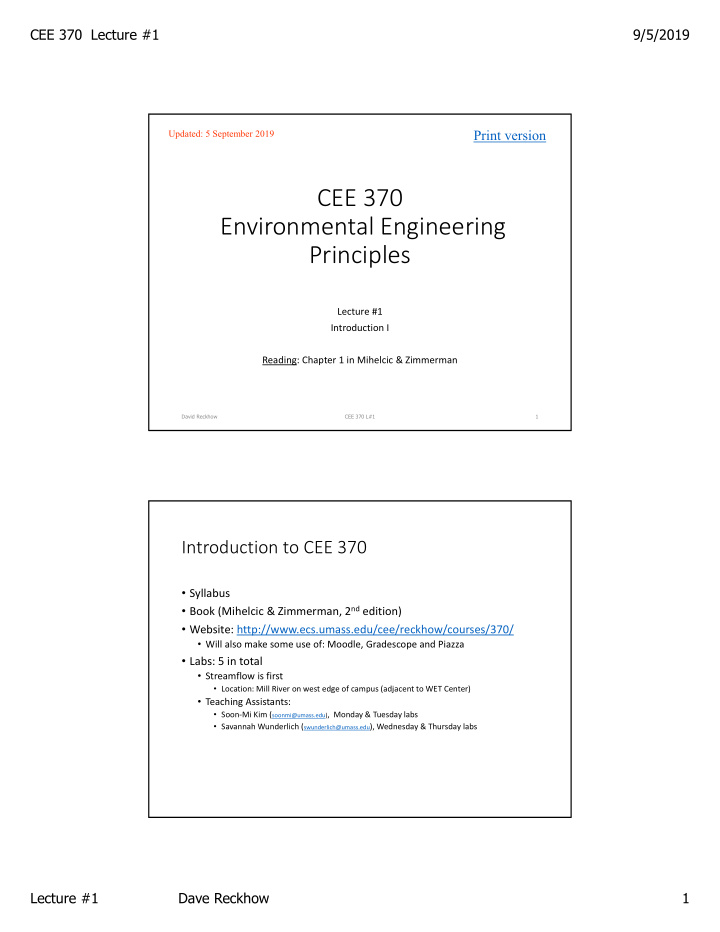



CEE 370 Lecture #1 9/5/2019 Print version Updated: 5 September 2019 CEE 370 Environmental Engineering Principles Lecture #1 Introduction I Reading: Chapter 1 in Mihelcic & Zimmerman David Reckhow CEE 370 L#1 1 Introduction to CEE 370 • Syllabus • Book (Mihelcic & Zimmerman, 2 nd edition) • Website: http://www.ecs.umass.edu/cee/reckhow/courses/370/ • Will also make some use of: Moodle, Gradescope and Piazza • Labs: 5 in total • Streamflow is first • Location: Mill River on west edge of campus (adjacent to WET Center) • Teaching Assistants: • Soon‐Mi Kim ( soonmi@umass.edu) , Monday & Tuesday labs • Savannah Wunderlich ( swunderlich@umass.edu ), Wednesday & Thursday labs Lecture #1 Dave Reckhow 1
CEE 370 Lecture #1 9/5/2019 370 Lab • This is our assigned lab room (Marston 24) as of this morning • We may use an alternative lab room in Goessmann for labs #2‐5 David Reckhow CEE 370 L#1 3 Lab #1 – measuring stream flow • Measure volumetric flow rate (Q) and mean velocity ( v ) of a small stream • How to do it? • Floating markers • Current meters • Chemical tracer dilution David Reckhow CEE 370 L#1 4 Lecture #1 Dave Reckhow 2
CEE 370 Lecture #1 9/5/2019 Electromagnetic Current Meter Method • Hach meter: Based on stream velocity at a specific point (depth and width) for a specified time frame (in seconds). 0.6D 0.2D 0.8D Electromagnetic sensors • Hach FH950 flow meter Images: www.hach.com David A. Reckhow CEE 370 Lab #1 6 Lecture #1 Dave Reckhow 3
CEE 370 Lecture #1 9/5/2019 Mill River Field Site • Teams of 3 • Use tape measure to define cross sections • Metal rod supports meter and sensor at the right depth • Need appropriate footwear David A. Reckhow CEE 370 Lab #1 7 Lab #1, Stream flow • Before: • Attend information sessions held during normal lab periods • Make groups of 3‐4. • Read and understand the lab session handout for next week’s lab exercise for all three methods. • Day of: • Expect to step into the stream (knee‐depth at most) so wear appropriate clothing (flip‐flops, shorts). • Bring a notebook to record your data and take notes. • Leave on time to reach WET Center by 2:30 PM • If you don’t know the directions and/or need a ride, talk to your TA. • Write‐up • Prepare a write up (1 per group) as per technical report handout and the lab handout (last couple of pages) • Turn in your write‐up as directed by TAs (1‐2 weeks after lab) Lecture #1 Dave Reckhow 4
CEE 370 Lecture #1 9/5/2019 How to dispose of Coke? • To minimize environmental & human impact, I should A. Pour it into the shrubs in front of Marston Hall during dry weather B. Wait until there’s a heavy rain and then pour it into the shrubs C. Pour it down the sink D. Pour it in the toilet E. Throw the entire can’s contents into the trash David Reckhow CEE 370 L#1 9 What’s in it? • John Stith Pemberton’s original formulation • Cocoa leaves (37 g/L; including ~ 36 mg/L cocaine) • Cola nut (with Caffeine) • Current formulation ‐ largely unknown except: • Monosaccharides: • 84 g/L fructose • 68 g/L glucose • Caffeine: 89 mg/L (caffeine citrate) • Phosphoric acid (172 mg‐P/L) • pH 2.3 David Reckhow CEE 370 L#1 10 Lecture #1 Dave Reckhow 5
CEE 370 Lecture #1 9/5/2019 A. Land disposal during “dry” weather • plume From Waterloo Hydrogeologic David Reckhow CEE 370 L#1 11 • Catch basin in front of Marston Hall B. In wet weather – to the storm drain system David Reckhow CEE 370 L#1 12 Lecture #1 Dave Reckhow 6
CEE 370 Lecture #1 9/5/2019 Catch Basins • UMass design David Reckhow CEE 370 L#1 13 UMass Amherst • Stormwater system David Reckhow CEE 370 L#2 14 Lecture #1 Dave Reckhow 7
CEE 370 Lecture #1 9/5/2019 UMass Amherst • Stormwater system David Reckhow CEE 370 L#2 15 NW segment • Mill River David Reckhow CEE 370 L#1 16 Lecture #1 Dave Reckhow 8
CEE 370 Lecture #1 9/5/2019 UMass Amherst outfalls • outfalls David Reckhow CEE 370 L#2 17 Outfall • “Dry” weather (3 Sept 2019) David Reckhow CEE 370 L#1 18 Lecture #1 Dave Reckhow 9
CEE 370 Lecture #1 9/5/2019 Mill River • Complete Watershed • Flows to Connecticut river Outfall David Reckhow CEE 370 L#1 19 C & D: The sink & toilet solution • Both go into the sanitary sewer system and on to the Amherst wastewater treatment plant Typical building plumbing system David Reckhow CEE 370 L#1 20 Lecture #1 Dave Reckhow 10
CEE 370 Lecture #1 9/5/2019 • dfas David Reckhow CEE 370 L#1 21 Amherst WWTP • Current plant David Reckhow CEE 370 L#1 22 Lecture #1 Dave Reckhow 11
CEE 370 Lecture #1 9/5/2019 Amherst WWTP • layout David Reckhow CEE 370 L#1 23 E: The trash can solution • UMass office of waste management (https://www.umass.edu/wastemanagement/ ) • Integrated solid waste management approach • The path • OWM trash packer truck to WRTF => transfer trailers to Holyoke transfer station => via rail to Southbridge MA landfill David Reckhow CEE 370 L#1 24 Lecture #1 Dave Reckhow 12
CEE 370 Lecture #1 9/5/2019 Southbridge landfill – the final resting place? • Capacity and contamination problems? From: Worcester Telegram, Nov 5, 2015 David Reckhow CEE 370 L#1 25 Landfills and groundwater • They all leak to some extent, especially unlined landfills David Reckhow CEE 370 L#1 26 Lecture #1 Dave Reckhow 13
CEE 370 Lecture #1 9/5/2019 Next • To next lecture • Reading for next class: • M&Z: Chapter 1 • Hardin’s “Tragedy of the Commons” Science, 13 Dec 1968 (pg 1243) Also on website David Reckhow CEE 370 L#1 27 Lecture #1 Dave Reckhow 14
Recommend
More recommend